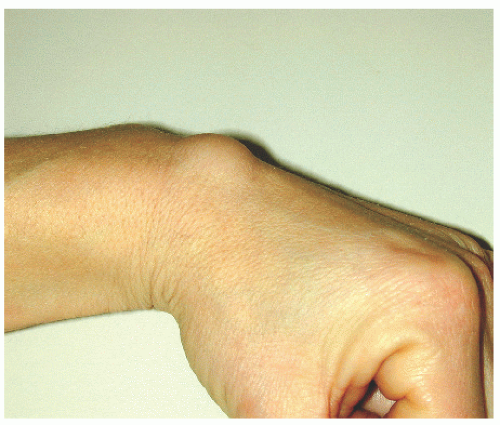Ganglion Cyst
David Bozentka
Lawrence W. Weber
CLINICAL PRESENTATION
Ganglion cyst is the most common soft tissue mass of the hand and wrist. Of all soft tissue masses of the hand and wrist, between 50% and 70% are diagnosed as ganglion cysts. The cysts are most commonly seen in the second to fourth decades of life. Women are three times more likely than men to develop a ganglion cyst. Most ganglion wrist cysts are asymptomatic and are often present for months to years prior to evaluation. Approximately 10% of patients will give a history of preceding trauma.1,2 Patients with a cyst may have discomfort that is often described as an ache. Small cysts of the dorsal wrist in the region of the scapholunate ligament tend to be more painful than large cysts. It has been proposed that pain associated with a dorsal wrist cyst at this location is related to impingement of the terminal branch of the posterior interosseous nerve branch, which innervates the dorsal wrist capsule. Therefore, these patients may note pain particularly when the wrist is held in full extension. Volar wrist ganglion cysts occasionally arise from the carpal canal and can lead to compression of the median nerve (Fig. 47-1). In this setting, symptoms of carpal tunnel syndrome may develop, with numbness occurring in the median nerve distribution. Similarly, cysts arising from the volar ulnar carpus may lead to compression of the ulnar nerve at the Guyon canal. These patients may present initially with symptoms of clumsiness and difficulty with fine manipulation due to ulnarly innervated intrinsic muscle weakness. The motor symptoms develop prior to the sensory symptoms because the motor fibers of the nerve are dorsal and the sensory fibers are more volar in the cross-sectional makeup of the ulnar nerve in this region.
Ganglion cysts can arise from a variety of locations, including joints, tendons, and nerves. Dorsal wrist joint cysts, which arise from the region of the scapholunate ligament (Fig. 47-2), are most common and account for approximately 60% to 70% of all ganglion cysts of the hand and wrist. Approximately 13% to 20% of wrist cysts arise from the volar aspect of the wrist.1 These volar cysts most often arise from the radiocarpal joint or scaphotrapezial joints. Volar radial cysts typically lie just radial to the flexor carpi radialis tendon and are often adherent to the radial artery (Fig. 47-3). Ganglion cysts may also arise from the ulnar aspect of the wrist, including the ulnar carpus and distal radial ulnar joint.
Histologic features of all ganglion cysts of the hand and wrist (i.e., dorsal wrist, volar wrist, dorsal distal interphalangeal joint, tendon sheath) are similar. The outer layer of a ganglion cyst is composed of randomly oriented collagen fibers with scant fibroblasts and mesenchymal cells. Ganglion cysts contain no synovial tissue and have no epithelial lining. The thick, gelatinous material contains glucosamine, hyaluronic acid, albumin, and globulin. Injection studies have shown that fluid communicates from the wrist into the cyst but not from the cyst back into the wrist.3,4
There are multiple theories regarding the pathogenesis of ganglion cysts. A herniation of synovial tissue through the wrist capsule has been proposed, although the lack of synovial tissue within the cyst is not consistent. It has been proposed that the leakage of synovial fluid from a rent in the joint capsule may cause an irritation of the surrounding tissue. The local tissue reacts by forming a pseudocapsule. The ganglion fluid develops related to the irritation of the synovial fluid and this tissue. An alternative theory considers mucinous degeneration as the main factor. The breakdown products of collagen collect in pools, leading to the formation of the cyst. Microtrauma involving repetitive stretching of the capsular tissues may also lead to the formation of hyaluronic acid by the mesenchymal cells and fibroblasts.1,5









